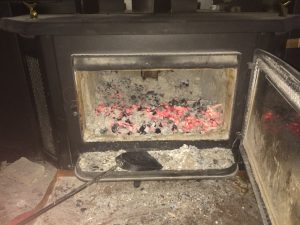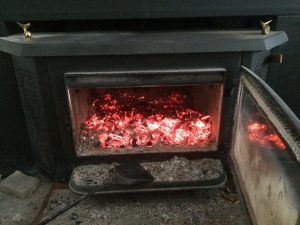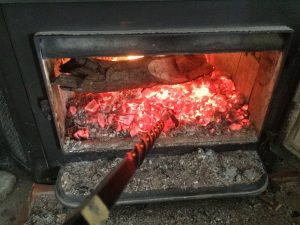Posts Tagged → energy
Speaking of cold weather, here is a wood stove review
Eleven years ago we purchased a new wood burning insert for the big fireplace in the living room. It replaced a small wood burning stove with a blower I had temporarily put there to finally project some real heat into the big space around it. Here is the review of the replacement wood burning insert.
This is an old stone house with beautiful fireplaces upstairs and down, begging to be put to use. Because the 16-inch-thick stone walls have zero insulation, wintertime becomes a simple question of how much energy can you dump into the first floor. The more you dump in, the only marginally more comfortable a person feels. The attic is fully insulated, and there are 1960s storm windows, but these are only part of the efficiency challenge. Basically the place is a big sieve, leaking energy out of every seam, nook, crevice, and old window, so it’s a battle we just won’t win. But with certain types of energy, like wood and coal, we can really keep shoveling it in and enjoy the relatively cheap rewards of abundant heat in one location.
Think of it as a family campfire in the living room.
As I grew up in a rough-sided home that heated only with wood (and where I would see my own breath vapor on winter mornings in my bedroom, because it was the farthest from a heat source), and I grew up splitting tons of wood all summer and fall as one of my chores, running a wood burning stove today is first nature to me. And I like it. Pictures over the years of the entire family snuggled together, asleep on top of and under wild game skins, in front of the fire, makes a dad’s heart grow fond for those early years, before the kids grew up and had their hands out all the time.
Somewhere in the 1970s a gas-burning log insert had been put in this living room fireplace, and we removed it in 2007. It was gaudy, silly looking, and highly vented, which meant it was a show horse and not a work horse. Its heat all went right up the chimney! Ambience? Barely. Heat? Zero.
Though I had my eye set on a QuadraFire 5100 insert, I was sweet talked out of that choice by a stove salesman in Mechanicsburg. He had worked with and for my dad for many years, many years ago, and because of that long relationship I figured he would not lead me astray. Well, that transaction ended up another lesson in “assume nothing,” because the Pacific Energy Summit insert we bought from him just absolutely sucks crap all damned day long. It is nearly trash, and at $5,000 installed, you don’t want or expect trash. It is nowhere near the performance of the QuadraFire, hell it is probably not even the performance of an open campfire.
The primary deficiency with the Pacific Energy Summit is it has a single rudimentary air intake, up front and center. Theoretically this location draws in fresh air across the fire and out the back as the gases are vented around the baffle and up the chimney, theoretically resulting in an even burn that consumes all the wood and produces a lot of heat.
Well, the Summit is a lesson in failed theory, because this one single source of air results in an oxygen-starved fire where 3/4 to 2/3 of the fire box is a mass of half-live half-dead coals and baked wood mixed with heavy ash, and the actual fire and source of heat is just up front by the door. It produces very little heat for all the massive amount of wood that is put in it. And do we ever shovel in the wood here, because the Summit just chews through it. Apparently the baffle is poorly designed, too, because you’d think the steel jacket surrounding the fire box would get hot, but it doesn’t. Most of whatever heat is produced just goes up the chimney, which is a waste of energy.
Our hunting cabin has a small QuadraFire wood stove, and it requires very little wood to turn the house into a hot sauna, even in the dead of frigid winter. Like our wood stove at the cabin, the QuadraFire 5100 insert I was talked out of also has four points of air entry into the fire box. Air entering from all these angles, front and back, results in an even burn that pulls maximum heat from the wood consumed in the fire box, and it also allows for a fine tuning of each fire. The ash from the QuadraFire is very light, very thin, which means all of the wood is being burned up and converted into fire.
Conversely, the wood ash from the Summit is heavy, meaning a lot of biotic material remains in it, which means it has not completely burned. It is no surprise, because the insert’s design is so bad. Had I not been sold a bill of goods by the Pacific Energy salesman, and had my natural skepticism that guides me so well in all other matters overcome my sense of loyalty to an old acquaintance, I would have purchased the QuadraFire 5100 and I would have been a much happier person for it.
A once-young logger I have worked with for the past twenty years has a QuadraFire 5100 insert at his cabin, and he really likes it. He told me it is “one of my few possessions that actually works correctly and which I would not sell, ever.”
On the other hand, I am about to give away this junky Pacific Energy Summit insert, which has eaten up so much of my hard-won firewood over the years. I would never buy another one.

Lame morning wood in the Pacific Energy Summit. A big bank of hot and cold coals raked forward to the front, the single source of air. This is its usual incomplete burn.

Pacific Energy Summit after a full burn and coals raked forward. An efficient wood stove will burn wood down into ash quickly. The Summit is so grossly inefficient that wood turns to a thick bed of coals that smothers the one single air intake and produces very little heat.
The Sad Situation in Standing Rock
A person must be cold blooded to not at least feel sad for the Standing Rock folks.
This is a group of ancient people who have watched their culture, lifestyle, property, and land heritage melt away under the weight of newer tribes. They really don’t have much left, and now a pipeline threatens to take away even more.
The Dakota Access pipeline is important, heck, all the new pipelines are important because energy independence is critical to American political independence. The more America can rely on domestic energy, the less we need foreign sources of energy. The less we depend on those foreign sources, the freer we are to make tough but necessary decisions about domestic and foreign policy.
What saddens me is the win-lose situation in Standing Rock. The pipeline is presented as a take-it-or-leave-it outcome. Surely there is some other way to resolve this, other than ramming it through. After all, that has been a hallmark of the failed Obama administration and their legislative allies on so many other policy fronts, ramming decisions down everyone’s throats. It is a negative way to run government. It unnecessarily creates winners and losers.
Creating winners and losers is a recipe for serious problems down the road. Resentment runs deep. Grudges are created. Losses are forever mourned.
I know from experience that the Standing Rock situation presents us with an opportunity to create winners and winners.
How well do I recall sitting in a conference room at my office in downtown Harrisburg in 2001. Gathered around the table were representatives from Audubon, Sierra Club, recreational ATV riders, hunters, trail hikers, and the timber industry.
I had successfully negotiated the purchase of a privately owned 12,500-acre inholding in the huge Sproul State Forest from the Litke family. Donna Litke was a neat Pennsylvanian who loved her family’s rugged wilderness land in the northcentral country, but who also had a fiduciary commitment to her family to get the best financial results possible from any purchase. Her private land would become public land after we acquired it.
But Everyone wanted the whole property for their own interests. Or they wanted to block their political opponents from getting something out of it.
After hearing all the crabbing from all sides, left and right, environmental groups and industry, I decided that we would not acquire the property unless everyone got something out of the deal. Everyone needed to share in the success, or else we were not going to see the deal close.
So the day we sat down with a map of the Litke land, and began to discuss where certain activities could or would best take place, was the day we began to get to a win-win outcome. In the end every interest group got something out of the acquisition. Audubon and Sierra Club saw certain sensitive lands there set aside as natural and wild areas, where logging, road building, and gas drilling would not occur. We created a 1,400-acre ATV riding area on reclaimed and unreclaimed coal mining land there, too, the first one on public land in Pennsylvania, which today has generated substantial economic activity in ultra-rural Beech Creek.
Much of the Litke forest was set aside as “plain vanilla” State Forest, where people can walk, hike, camp, hunt, trap, fish, and cut timber. The streamside railway that came with it became an important rail-trail, drawing tourists (and their dollars) from far and wide.
And I did not learn how to do this cold. Rather, in 1995 to 1996, I had successfully used the same approach in the Middle East Peace Process agricultural projects in Jordan, Israel, and the West Bank when I was at US EPA, representing our agency in the diplomatic process.
Boy, you talk about competing interests! There was no shortage there, but in the end I was dubbed “Little Kissinger” for the sidebar negotiations I created, which got the overall projects back on track. Winners and winners.
My hope is Standing Rock will provoke the best in us. Barack Hussein Obama did nothing to help the folks there, until two weeks ago he made a purely political and symbolic decision against the pipeline. Obama has always been about winners and losers, heck he enjoys creating losers, so who can be surprised by his action here. Like everywhere else over his eight-year tenure, Obama squandered an opportunity to facilitate competing interests find common ground.
And that is what needs to happen at Standing Rock: Common ground.
Aren’t there potential solutions to this standoff that are win-win? I can think of three or four potential solutions that would probably be acceptable to the main parties.
We have a new president who understands the concept and importance of win-win outcomes. Hopefully President Trump appoints a solid and good-faith negotiator to resolve the head-on collision at Standing Rock, for everyone’s benefit.
Winners and winners.
An outdoor lifestyle, halfway through the season (to hunt is human)
Most of the readers who visit this blog are not outdoors folk. Feats, exploits, and the inevitable tales of woe, cold, and misery from the field would naturally bore, or at best morbidly fascinate, the non-hunter.
Nevertheless, here we go, for the first time here, on a midway retrospective of a singular hunting season still unfolding.
Hunting for most hunters is a way of life literally built into our genes. We do what humans have done since the rise of Homo Sapiens upon Planet Earth: Hunt animals that we eat, wear, and admire. While the Pleistocene ended only 20,000 years ago, it is marked by the full arrival of adept hunter-gatherers who had spent tens of thousands of previous years perfecting their lifestyle.
Humans have been hunters and gatherers for 100,000 years, or 60,000 years, depending upon how long one believes Homo Sapiens has been human.
We have been agrarian for what…10,000 years at the most generous definition of the sedentary lifestyle, but closer to 5,000 years for most humans.
After that, the most modern, most technologically advanced, most “civilized” humans have lived through the Industrial Revolution (400 years), the Technological Revolution (150 years), the Information Revolution (50 years and ongoing). Combined, that’s a total of 600 years out of a total of 60,000 years.
At our core we are all hunter-gatherers. Scratch our civilized surface, and right underneath we are all spear-toting, skin-clad hunters.
To hunt is innately human. Hunting makes us human.
In other words, although many people today look at our current effete, energy-intensive Western lifestyle and think of it as being the peak of human civilization, some of us see this civilization as becoming complacent, detached from the reality of natural resource management necessary to support this modern lifestyle, hypocritical.
When someone believes it is morally superior to have an assassin kill their meat for them than to kill it themselves, you’ve got an unsustainable logical break. Similarly, people want “the government” to protect them, and they want to prevent citizens from protecting themselves, and those same citizens cannot hold the same government accountable when it fails.
Western civilization is full of this weak thinking. In my opinion, Western society is becoming hollow, a shell, full of contradictions.
The hunting lifestyle is a powerful antidote. It is a dose of reality inserted into a cloudy drugged up dream.
So far, this season has been marked by time afield in the most beautiful places in several states with long time friends, new friends, my young son, other kids, and by myself. Like our Pleistocene ancestors, the feeling of the pack on my back and the game-getter in my right hand is about the most natural and satisfying feeling possible.
A number of deer have fallen to various firearms, a Fall turkey, a colorful pheasant; there’s a bunch of photos commemorating the times for the results-oriented. My best moment was late at night, checking a trap with my boy, and finding a large bobcat. There for about four hours, it had really no taste for humans and represented the wilderness in all its wildness.
Catching a bobcat is a real achievement in the world of hunting and trapping, and I confess it was with great mixed emotions that we dispatched it and brought it to Butch at Blue Mountain Taxidermy. Even if a bobcat is again in one of our traps during the short bobcat season, we will release it. One is enough for a lifetime.
One bobcat trophy represents a lifetime of time afield, or 60,000 years.
Natural resource envy
Being a conservationist, I’m on a bunch of email lists about conservation, natural resources, environmental protection.
Why and how groups send emails decrying natural resource companies, while happily using those same resources, like oil, coal, and natural gas, is beyond comprehension.
Oil and gas companies serve a demand by consumers who want their cars to run, their stoves to cook.
Coal powered electricity is ubiquitous. It runs hospitals and schools, as well as your home and place of business.
Somehow, in a twisted way, the companies supplying the power are “bad,” and the consumers are off the hook. As if these companies operate in a vacuum.
Credibility suffers when you’ve got two or more standards for the same behavior. It’s sad because environmental quality is important. My request to conservatives is to not dismissively abandon the field of battle, and don’t let the far left define or frame the issue, either. And don’t let the leftist groups get away with demonization of companies the world depends upon, unless those same groups are willing to generate their own power and transportation fuels.
